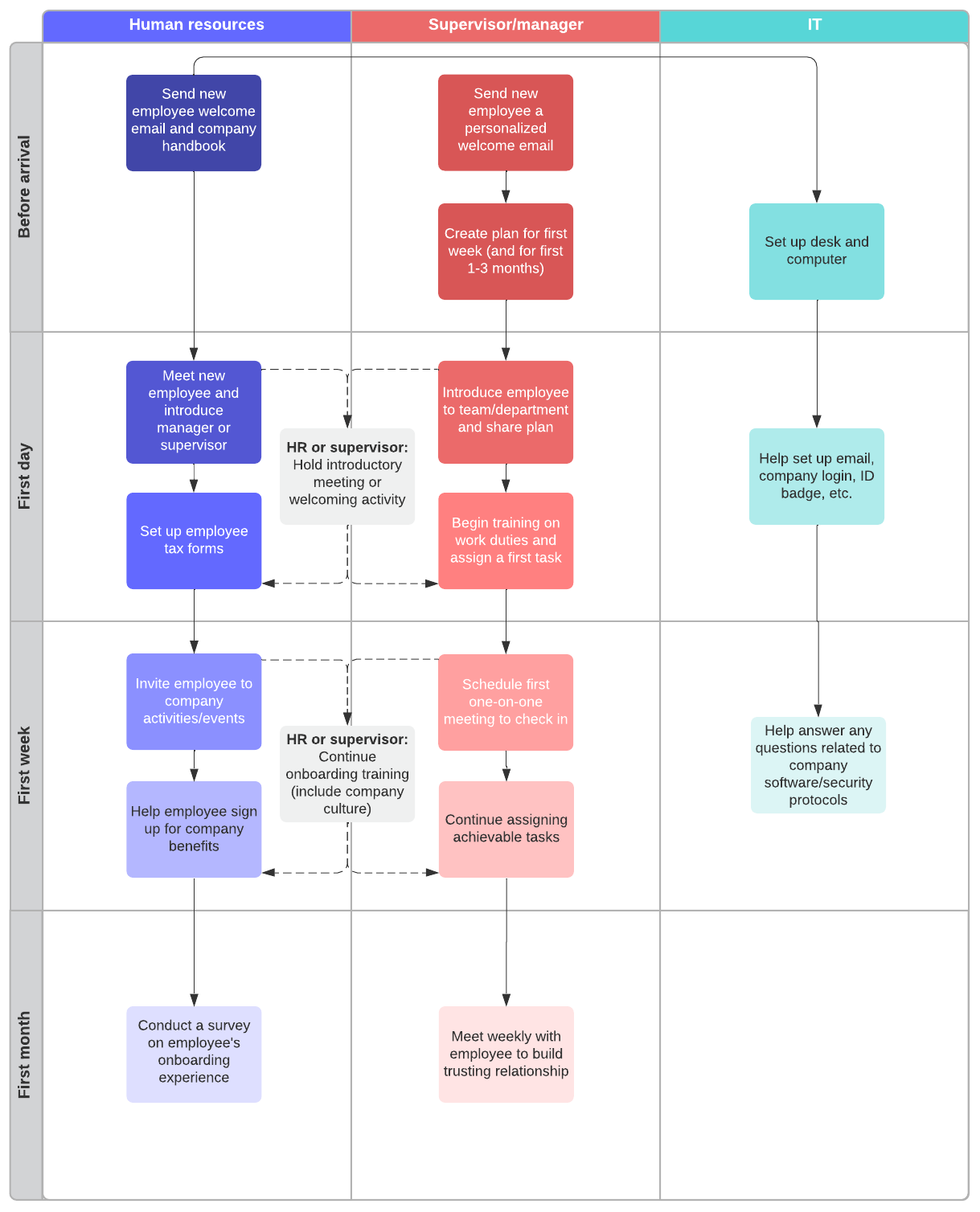
3 challenges of managing a hybrid team and how to overcome them
Reading time: about 7 min
When most people talk about what it’s like being part of a hybrid team or working from home, the conversation often covers flexible schedules, cost savings, or better work-life balance—great benefits for remote employees. But what about managing a hybrid team?
Managing a hybrid team can sometimes be overwhelming. Especially when employees expect a certain level of freedom as remote workers yet the demand for overall productivity remains the same (if not higher). What can you do to improve the way your hybrid team works together?
If you’re managing a hybrid team at your organization, here are three challenges you may face and the strategies you’ll need to overcome them.
Challenge 1: Keeping processes consistent across team members
When managing a hybrid team, you try to give employees some autonomy and flexibility in their work. Some team members thrive with such freedom. Others miss the structure and consistency of working together in person where processes are often more established.
Without setting clear expectations or creating proper guidelines for your hybrid team, it will prove difficult to measure, guide, or enhance team members’ performance.
Establishing new norms for how your hybrid team operates also requires you to rethink your own expectations and guidelines for managing a hybrid team. What methodologies and procedures are you relying on currently that don’t make sense for a hybrid workplace?
Some of the solutions you should consider introducing for the benefit of your hybrid team include:
Centralized documentation
To manage workflow, encourage collaboration, and ensure process continuity, keeping essential documents readily available whether online or in person is a must for any hybrid team. With online access to documents, team members can more easily share the knowledge it takes to collaborate and communicate together.
When it comes to managing a hybrid team, centralized documentation builds more trust among employees, encourages teamwork, and increases efficiency with transparency.
Clear expectations
Keeping processes consistent across team members is that much easier if your process for managing a hybrid team is clear and efficient from the onset. And this begins with simple, yet firm rules of engagement. When everyone knows what to expect or how to act accordingly, you pave the way for productivity on the team.
With the right guidelines, team members will know which issues make sense to discuss in chat or email versus which ones warrant further attention in a meeting.
If certain aspects of managing a hybrid team at your organization require employees to check in, make sure this expectation is built into the hybrid process of your workforce.
Using visuals where relevant
To quickly share the details of your team’s processes and make sure they’re easily understood by everyone on your hybrid team, using visuals can be highly effective.
With its power to convey ideas through intelligent diagramming, Lucidchart is a great application for creating and documenting processes visually. Editable in real time and shared online, use Lucidchart to identify bottlenecks, show areas of improvement, visualize which team members are responsible for different stages of a process, and more.
Challenge 2: Decision-making around processes happening asynchronously
People take for granted just how much communication occurs in real time. And it’s not just limited to the time spent in the office or attending in-person meetings. It’s in the spontaneous conversations at your desk or in the break room. Or the ability to jump on a group call together at a moment’s notice.
When managing a hybrid team, there are times when it’s difficult to get everyone in the same time zone, let alone on the same page. With a hybrid team, asynchronous communication can be a challenge, especially when decision-making is involved.
Even with instant messaging, emails, and video conferencing, interactions between the members of a hybrid team aren’t always instantaneous. Delayed responses sometimes result in held-up decisions or a lack of consensus.
Fortunately, there are proven strategies you can employ to address the shortcomings of asynchronous communication that occur while managing a hybrid team. Starting with:
Frequent check-ins
It’s important to commit time each week to meet with your direct reports, both as a group in weekly videoconference gatherings and in 1:1 meetings. Hosting 1:1s on a regular basis around employee schedules gives you opportunities to:
- Give and solicit feedback with your direct reports.
- Highlight individual performance and team goals.
- Clarify expectations and hybrid team processes.
Check-ins are also great for addressing any questions your team members raise about the projects they’re working on or identify situations where additional support is needed.
Real-time collaboration software
Even with the best planning, there will always be times when real-time collaboration proves difficult. Just because members of your hybrid team can’t get together on a call or videoconference at the same time, doesn’t mean you can’t coordinate team efforts or brainstorm new ideas in an instant.
Whether you’re in different time zones or on different devices, the Lucid Visual Collaboration Suite offers the ideal collaborative workspace for those working remotely on a hybrid team. Combining the power of intelligent diagramming with virtual whiteboarding, it affords everyone a single source of truth, visually and efficiently. It also helps to boost team alignment and productivity in real time.
Challenge 3: Getting new team members up to speed
Under the most ideal circumstances in a traditional office setting, helping new hires feel fully prepared to take on their roles and grasp the details of your company’s processes takes coordination and effort. Managing a hybrid team’s onboarding takes even more.
Within your hybrid process approach, it’s critical to ensure every employee understands the mission, values, and culture of your organization from the very beginning. Ultimately, the way you onboard new team members will impact how quickly they get up to speed.
Because of the unique dynamic involved in managing a hybrid team, extra attention will be needed throughout the onboarding process for newly hired, remote employees. Some of the strategies and approaches that you should embrace across the company include:
Overcommunicating
When managing a hybrid team, people almost never communicate enough. Within a hybrid structure, new hires don’t always have the luxury to get undivided attention from their manager or seek impromptu advice from coworkers.
Rather than overwhelming new employees on their first day with your hybrid team, make a point of communicating with them in the time before they get started. Coordinate your efforts with HR, IT, and other departments involved in the onboarding process.
Plan on virtually introducing all of your new hires to the existing members of your hybrid team. Rather than put people on the spot, ask them to fill a new employee profile ahead of their start date.
Overcommunicating throughout their first few weeks on the job can also take the form of regular check-ins and follow-ups. Schedule a 1:1 session each week to note how things are going, resolve issues, and give everyone the chance to feel seen, valued, and heard.
As new hires are assigned to complete onboarding tasks, you should provide them with the following:
Clear documentation
Every role within every organization includes its own set of tasks or responsibilities to be fulfilled during a particular time frame after their hire date—typically the first 30 to 90 days on the job. Whether it’s the successful completion of training videos, participating in a virtual office tour, or setting up their remote workspace, everything a new hire needs to know should be accessible online.
Collaboration software and tools
Whether conducted in person or virtually, so much of the onboarding process is an individual journey. Of course, this doesn’t mean that new hires are left entirely to themselves to check all the boxes as they make the transition.
With Lucidchart, managers can use data visualization to guide new employees through the onboarding process. Graphic flowcharts can standardize (and simplify) the steps of the onboarding process. Because of just how easily they can be created and edited in Lucidchart, custom flowcharts can be made specific to each job role and its process.

And for day-to-day communication with managers and peers, don’t underestimate the ability of impromptu chat or video conferences with collaboration tools like Microsoft Teams, Slack, or Zoom. Communication channels dedicated to new hires can also be created to keep all those employees in touch throughout their shared onboarding experience and beyond.

If you’re managing a hybrid team at your organization, here are three challenges you may face and the strategies you’ll need to overcome them.
Read moreAbout Lucidchart
Lucidchart, a cloud-based intelligent diagramming application, is a core component of Lucid Software's Visual Collaboration Suite. This intuitive, cloud-based solution empowers teams to collaborate in real-time to build flowcharts, mockups, UML diagrams, customer journey maps, and more. Lucidchart propels teams forward to build the future faster. Lucid is proud to serve top businesses around the world, including customers such as Google, GE, and NBC Universal, and 99% of the Fortune 500. Lucid partners with industry leaders, including Google, Atlassian, and Microsoft. Since its founding, Lucid has received numerous awards for its products, business, and workplace culture. For more information, visit lucidchart.com.
Related articles
What makes an effective hybrid workplace?
In this blog post, we will explore the components of an effective hybrid workplace, and which tools can enhance your team collaboration.
Documenting processes for hybrid teams
In this blog post, we will learn why process documentation is important, and how to document your own, step by step.
